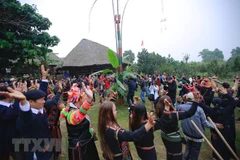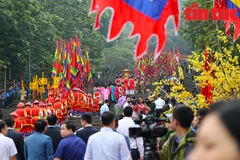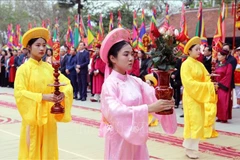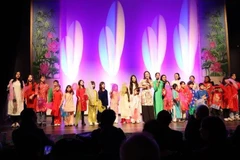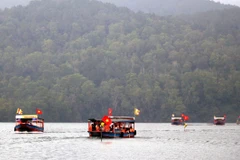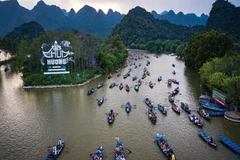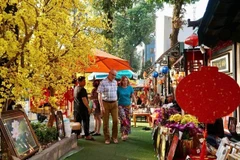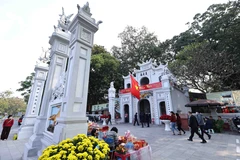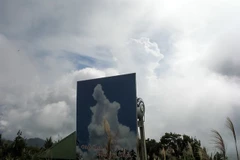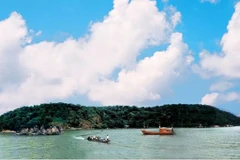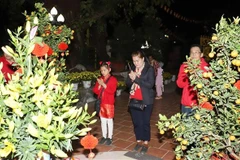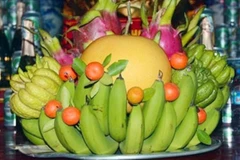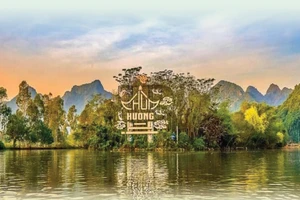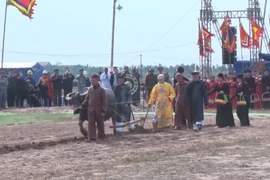The Lam Kinh historical sitein the province of Thanh Hoa received a certificate recognising it as aspecial national relic at a ceremony on September 26.
Each year, on the death anniversary of Le Loi (the twenty-second dayof the eight lunar month), pilgrims across the country flock to Lam Kinhhistorical site in Thanh Hoa province, the homeland of the nationalhero.
Located in Xuan Lam commune, Tho Xuandistrict, the site is also known as the beginning place of the historicLam Son uprising in the 15th century, which always inspires the nationalpride among Vietnamese people.
" Although I’m 80years old, I want to come back to Thanh Hoa province to visit the LamKinh heritage complex. Living far from my hometown, I always think of myancestors’ land and I’m grateful to our predecessors for theircontributions to the national construction, " said Nguyen Thi Hue,who is living in Ho Chi Minh City.
After offeringincenses to the royal members of the late Le dynasty at the Le temple inDong Ve ward in Thanh Hoa province, and paying tribute to Le Loi at hismonument in the central of Thanh Hoa city, visitors can go along 47highway in the direction of Thanh Hoa’s mountain areas, which isstrongly associated to the Lam Son uprising.
According to Professor Vu Ngoc Khanh, the primitive motivation of theuprising originated from the current situation of the country and themiserable living of the people at that time. This brought togetherpatriots, led by Le Loi, to the Lung Nhai Oath Ceremony in 1416 toannounce their mission of liberating the country from the domination ofChinese Ming invaders and brining a peaceful life for their compatriots.
Le Loi and his insurgent army claimed victory in1427. He came to the throne with the title of Le Thai To in 1428,establishing himself as the first king of the late Le dynasty(1427-1789). He set up the capital in Thang Long (now Hanoi) and renamedit as Dong Kinh. He also advocated to upgrade his birthplace, Lam Son,into the second capital and named it Lam Kinh, alias Tay Kinh.
Along with policies on recovering the country, developing economics,strengthening military and defence, the promulgation of a law code, thelate Le dynasty was also highlighted in the history with outstandingachievements in culture and arts, and education and training.
After nearly 600 years experiencing fierce weather condition andwartime, the original value of Lam Kinh now can be found underground asmost of constructions built there under the late Le dynasty were badlydamaged.
On October 22, 1994, the Prime Ministerapproved a master project on preserving and restoring the Lam Kinhhistorical site. Thence, many solutions have been taken to preserve andpromote the original value of the complex.
Expertsfrom the Vietnam National Museum of History have conducted sixarchaeological excavations at this site, which unearthed many culturallayers and numerous relics. These excavations also revealed thefoundation and architectural structure of the complex as well as tens ofthousands of artifacts dated from the early Le, including worshippingitems and daily utensils. The artifacts have provided scientific basisto restore the site true to its origin.
Head of LamKinh Heritage Management Board Trinh Dinh Duong affirmed that duringnearly 20 years since various researches and restoration work have beenimplemented under the project; the Lam Kinh complex has unveiled its "hidden " value.
Thanks to the project, tens ofthe construction items have been restored and upgraded, including fiveimperial temples, a royal court, Ngoc river, Bach bridge, system oftombs, stele houses and a temple commemorating King Le Thai To in XuanLam commune, Tho Xuan district.
A number of newconstructions have also been built in the site in on the basis ofmaintaining its original value and exploiting its advantage in spiritualtourism.
Thanh Hoa provincial authorities have alsoissued policies on encouraging and attracting investments to the siteand have designed tourist services and products to satisfy visitors’demand.
These efforts to promoting the herniate sitewere finally rewarded. In the first eight months of this year, the sitereceived 50,000 visitors. In 2012, the complex welcomed around 60,000visitors, an increase of 20% over the last year, including 700 foreigntourists from Japan, the Republic of Korea, China and the United States.
Visitors to the complex’s exhibition house areintroduced to 20,000 antiquities, including big-sizes bricks, tiles,items decorated with dragon patterns, and ceramic artifacts.
On the east side of the complex, they can visit the King’s well, thecentury-old banian tree, which was recently recognised as the nationalheritage by the Vietnam Association for Conservation of Nature andEnvironment in August this year.
On the west side ofthe complex, the tourists can have a look at the Vinh Lang stele, whichfeatured the life and career of King Le Thai To. The stele, made ofsedimentary rock, is 2.79 metres high, 1.94 metres wide and 27centimetres thick.
Entering the Dragon royal court,the tourists can contemplate the architectural structure of Lam Kinhsanctum, including Quang Duc, Sung Hieu and Dien Khanh palaces, and ninetemples commemorating the queens.
In a bid touphold the value of the historical site, in 2005, under the support ofthe Ministry of Culture, Sports and Tourism, Thanh Hoa provincialauthorities restored the traditional Lam Kinh festival, particularlyroyal and folklore performances. The site’s management board hasactively studied and collected legends about Lam Son insurgent troop andtraditional crafts of Lam Son land. Local residents have donatedthousands of artifacts dated back to the period to complement and enrichthe exhibits of the Lam Son cultural space.
Thisyear’s Lam Kinh festival officially kicked off on September 26 incelebration of the 595th anniversary of Lam Son uprising and the 580thdeath anniversary of Le Loi.
In addition totraditional ceremony, the two-day festival features a stage programmereenacting the heroic and glorious Lam Son upraising as well as folkgames of Thanh Hoa province.
Various activitiespaying tribute to King Le Thai To, cultural and arts performances andsporting events also take place across the province. Documentaries onVietnamese great men of culture, celluloid films on historical theme andreportages on Lam Kinh complex are screened for audiences during thefestival. On the occasion, Thanh Hoa provincial authorities receive acertificate honouring Lam Kinh as a Special National Heritage Site.
Lam Kinh complex, the confluence of heritages in Thanh Hoa province,is not only a tourist site but also provides visitors with anopportunity to study the history, tradition and cultural identities ofVietnamese people.-VNA

